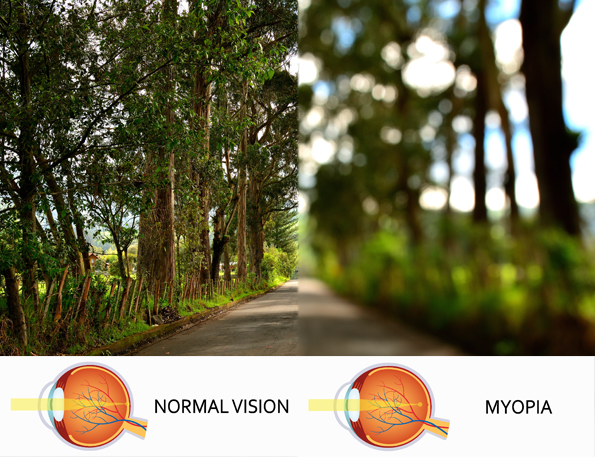
Mild Myopia
- Myopic Macular Degeneration - 13.6x
- Glaucome (OA) - 1.6x
- Retinal Detachment - 3.2x
Moderate Myopia
- Myopic Macular Degeneration - 72.7x
- Glaucoma (OA) - 2.9x
- Retinal Detachment - 8.7x
High Myopia
- Myopic Macular Degeneration - 845.1x
- Glauome (OA) - 2.9x
- Retinal Detachment - 12.6x
* Haarman AE et al. THE COMPLICATIONS OF MYOPIA: A review and meta-analysis. Investigative Ophthalmology & Visual Science (2020 April 9; 61:49)
Continuous Blurred Vision
If your vision is blurred when you are focusing on objects that are far away from you, then you know that you are nearsighted. Being nearsighted does not necessarily mean you have to continue having burring vision though.
Continuous blurred vision can drastically limit your vision range and shortened vision range is a key indicator of high myopia.
With timely medical intervention, you can end blurry vision.
Eye Strain
Eye strain comes with may symptoms such as blurry vision, dry or watery eyes, itching eys, headaches, heightened sensitivity to light and the need to keep eyes closed. Additionally, it can cause irritation as the patient battles with staying focuses and controlled.
To limit the frequency and severity of eye strain, it is advisable to visit an optometrist for checkup and treatment.
Exposure to other eye complications
Patients that are nearsighted that do not use glasses, contact lenses or treatment such as Ortho-K or Atropine therapy, risk being exposed to other eye complications. Among long term complications are Gluacoma, Myopic Macular Degneration, Cataracts and others.
Left untreated, Myopia will progress and potentially lead to irrevesible loss of vision.
Select your preferred date, time and location and once confirmed we will send you a confirmation email.
